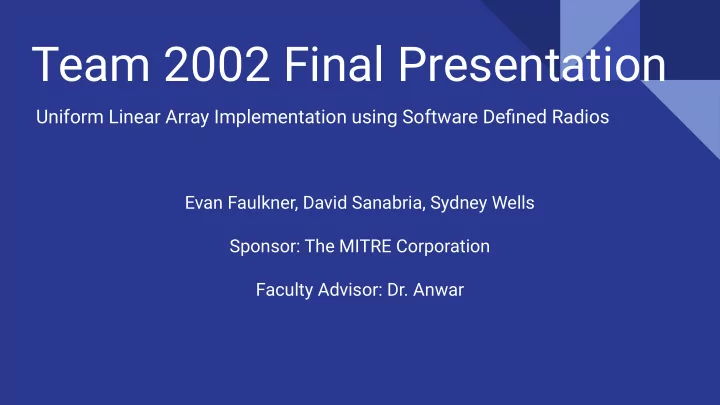

Team 2002 Final Presentation Uniform Linear Array Implementation using Software Defined Radios Evan Faulkner, David Sanabria, Sydney Wells Sponsor: The MITRE Corporation Faculty Advisor: Dr. Anwar
Background Underwater communication has numerous applications [1] ● ○ Science: geological surveys, underwater archaeology, and deep ocean exploration ○ Government: Fish population management, harbor safety, and coastal inspection ○ Industry: Oil field discovery and maintenance Military: Submarines and Unmanned Underwater Vehicles (UUVs) ○ The most common solution is to use acoustics [1] ● Low power ○ ○ Well studied ○ Compact ○ Longer range than electromagnetic waves
Background The underwater acoustic channel presents several challenges [2] ● Variation in time depending on conditions and location ○ Multipath effects and strange signal propagation ○ ○ Doppler shift from relative motion of hydrophones ○ Doppler spreading due to surface interaction Beamforming is one of many viable strategies to combat these issues [3] ● A Uniform Linear Array (ULA) is the simplest configuration ○
Peter Willett. ECE 6123 Advanced Signal Processing. Lecture Notes, “Spectral Estimation.” Department of Electrical and Computer Engineering, University of Connecticut, Fall 2017.
Project Goals ● Develop the capability to prototype a ULA on a Software Defined Radio (SDR) platform in a lab environment ● Demonstrate the ability to steer transmissions and receptions using multiple hydrophone elements. ● Evaluate beamforming capability using SDR hardware and wired connections
Design Considerations ● Time domain vs. frequency domain beamforming Element spacing ● Number of elements ● ● Windowing ● Steering and Nulling
Spatial Aliasing Spatial aliasing occurs when the spacing of the elements is larger than half the wavelength ● of incident sound waves Ensure appropriate aperture by adjusting spacing and number of elements ●
Technical Solution Phase 1 MATLAB development of beamforming capability in simulated channels a. AWGN and Stojanovic channels adapted for use with arrays b. Custom time domain and frequency domain beamformers c. Testing beamformers for transmission and reception of QPSK signals over the AWGN, Rician, Autoregressive, and Stojanovic channels
Current Progress ● Time domain beamforming simulation with QPSK transmission complete
Current Progress ● Successful beam forming and QPSK demodulation
Current Progress ● Simulation in AWGN, Rician, and Autoregressive channels in progress
Current Progress ● Evaluation of beamforming performance vs. number of elements
Technical Solution Phase 2 Creation of a beamforming application for Ettus X310 SDRs a. C++ development b. 2 element transmitter arrays, 4 element receiver arrays c. Adjustable parameters for windowing, number of elements, etc. d. Testing transmitter and receiver beamforming over simulated channels e. Exploration of real channels or additional array element capability
Hardware ● Provided by MITRE ● Two Ettus X310 USRP software defined radios to send and receive real signals ○ Two wide-bandwidth daughterboards slots C++/Python compatible ○ Two UDOO x86 boards to operate as ● Host Computers ○ Windows, Linux, and Android compatible
Fall 2019 Project Timeline
Spring 2020 Project Timeline
RACI Chart Evan Sydney David Mitre Dr. Anwar R R R A I Matlab Development R R I A I Beam Forming R I R A I Rician/Autoregression Channel I R R A I C++ SDR Development R R R A I Acoustic Communications Research I I I R I Stojanovic Acoustic Channel R R R C A Reports and Presentations
References 1) Shengli Zhou and Zhaohui Wang, OFDM for Underwater Acoustic Communications , Hoboken, NJ: John Wiley and Sons, 2014. [E-book] Available: https://learning.oreilly.com/library/view/ofdm-for-underwater/9781118693810/. [Accessed Oct. 17, 2019]. 2) John Heidemann, Milica Stojanovic, and Michele Zorzi, “Underwater sensor networks:applications, advances, and challenges,” Philosophical Transactions of the Royal Society A: Mathematical, Physical and Engineering Sciences , vol. 370, issue 1958, pp. 158-175. [Online]. Available: https://royalsocietypublishing.org/doi/pdf/10.1098/rsta.2011.0214. [Accessed Oct. 16, 2019]. 3) H. L. V. Trees, Optimum Array Processing . New York: John Wiley and Sons, 2002, p. 1-8. 4) Amy Nordrum, “Nato Unveils JANUS, First Standardized Acoustic Protocol for Undersea Systems,” IEEE Spectrum , Jul 17, 2007. [Online]. Available: https://spectrum.ieee.org/tech-talk/telecom/wireless/nato-develops-first-standardized-acoustic-sign al-for-underwater-communications. [Accessed Oct. 16, 2019].
References 5) F. Jia, E. Cheng and F. Yuan, "The study on time-variant characteristics of under water acoustic channels," 2012 International Conference on Systems and Informatics (ICSAI2012) , Yantai, 2012, pp. 1650-1654. [Online]. Available: https://ieeexplore.ieee.org/document/6223357. [Accessed on Oct 16, 2019]. 6) J. A. Catipovic, "Performance limitations in underwater acoustic telemetry," in IEEE Journal of Oceanic Engineering , vol. 15, no. 3, pp. 205-216, July 1990. [Online]. Available: https://ieeexplore.ieee.org/document/107149. [Accessed on Oct 17, 2019]. 7) Thesis: Eggen, Trym H., "Underwater acoustic communication over Doppler spread channels", 1997-06, DOI:10.1575/1912/5709, https://hdl.handle.net/1912/5709
Recommend
More recommend